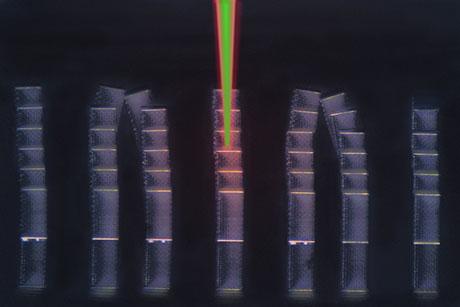Microbes chow down on latest fuel-cell tech
You can quickly run out of fingers and toes counting the many ways we waste energy. Take our sewage systems, for example: The energetic content of wastewater is about 10 times the amount of energy it takes to process it. In the U.S., we spend 3 percent of our energy on processing wastewater, which means the equivalent of some 30 percent of our energy is simply draining away.
"Even if you could get only a fraction of that back, you could offset the amount of energy it takes to process the wastewater, and potentially sell some back to grid," says Cullen Buie, who heads up MIT's Laboratory for Energy and Microsystems Innovation (LEMI). "We're working on a way to use microbial fuel cells to harvest some of the energy that is currently being flushed down the toilet."
Buie's work on microbial fuel cells is just one effort of many at LEMI, where projects draw upon fields including microfluidics, electrokinetics, electrochemistry, and microscale surface engineering. In addition to microbial fuel cells, potential applications include biodiesel harvesting, cell sorting for genetic research, ship-hull protection, and perhaps Buie's biggest breakthrough to date: a low-cost, hydrogen bromine flow battery that doesn't require a membrane.
Buie founded LEMI when he arrived at MIT in 2010. "The lab encompasses all the things that interest me, including alternative energy," says Buie, an assistant professor of mechanical engineering. "A lot of our applications are dependent on microscale manipulation or principles of microfluidics. We also look at electric fields in fluid flow in order to discriminate, or sort cells, based on physical properties."
Like a chemical fuel cell, a microbial fuel cell consumes fuel and an oxidant and produces useful energy that gives off byproducts, such as heat. As the cost of chemical fuel-cell catalysts increases, the technology is receiving greater attention.
"Instead of requiring a precious-metals catalyst such as platinum, microbial fuel cells use bacteria, which live on electrodes and eat fuel," Buie explains. "As a byproduct of respiration, they release electrons to the electrode, providing energy you can harvest for electricity."
The main limitation of the technology is low power density, resulting in low conversion rates. To run an automobile, for example, a bank of microbial fuel cells would need to be bigger than the car itself, Buie says. "Yet the efficiency is so high, it would be ideal for lightweight wastewater treatment, where normally there's not much else you could do with that stream," he adds. "A food-processing facility could use [microbial fuel cells] to treat wastewater from food processing before releasing it to the municipality for treatment."
To scale microbial fuel cells up for larger systems, further study is needed on microscale interactions, Buie says. "Microbes are only one micron in size, so to understand the flow of reactants and electrons, and how the geometry of the system affects cells, you need to probe an environment that is closer to their scale," he says.
LEMI has developed tiny, microfluidic microbial fuel cells to explore how the local environment affects the ability of cells to transform organic materials, sugars, and acetate into electricity. To improve efficiency in wastewater treatment, the lab is also studying wastewater fluid flow.
"Most of the work in this area has been done by biologists, so the emphasis has been on the organisms," Buie says. "But as we work toward practical devices, we need to understand things like fluid mechanics, materials, and transport. The scale of treatment facilities is huge, so we need to understand how scale-up will affect local biology. We must know what mechanisms are needed to get these flows in and out most efficiently, and allow these organisms to thrive on an electrode."
Membrane-free flow technology aims for tougher, cheaper batteries
LEMI, in collaboration with Professor Martin Bazant in MIT's Department of Chemical Engineering, is also working on a different kind of electrochemical cell called a hydrogen bromine flow battery. The basic design was first developed in the 1970s, and holds certain key advantages over traditional hydrogen-oxygen fuel cells: For example, to get a suitably high concentration of oxygen, one must compress it in a large and expensive tank. Bromine, on the other hand, is not only inexpensive, but it's liquid at room temperature, so you can dissolve it in water or hydrobromic acid in high concentrations.
The hydrogen bromine flow battery is also more flexible. "It's kind of like a reversible fuel cell, because it operates in two directions," Buie explains. In one direction, you "flow in" hydrogen and bromine, yielding useful energy, waste heat, and hydrobromic acid. In the opposite direction, you flow in hydrobromic acid and electricity to yield hydrogen and bromine.
The technology has stalled, however, due to the challenge of developing an electrolyte membrane that can separate the reactants while enabling consistent reactions over time. The membrane tends to become corroded by the hydrobromic acid.
Buie tried a different approach. "What we've done is develop a system that has no membrane at all," he says. "Instead, we use fluid mechanics to separate the reactions of the anode and cathode."
The idea of using fluid mechanics to enable a membraneless system was developed at Harvard University about a decade ago, but was initially largely ignored, due to its low power output. Buie's innovation was to refine the process and combine it with an enhanced version of the hydrogen bromine flow battery.
Because the membrane represents 30 to 40 percent of the cost, Buie's design should also be much cheaper. "Our system not only enables higher durability and longer life, but you remove the single most expensive component," Buie says.
The membrane-free battery also enables a very compact device with very high power density. "We have been able to demonstrate some of the highest power densities of any electrochemical system of any chemistry," Buie says. "You get a lot of energy out for the bromine you put in."
LEMI has begun work on scaling up its hydrogen bromine battery prototypes, and is actively looking for partners and applying for grants, Buie says. "We may even start a company around it," he says. "There's a huge market potential, mainly in energy storage, due to the expansion of renewables like wind and solar. Storage mechanisms can curb the intermittency of renewables."
Spying on cells with DEP
Several other LEMI projects harness the power of dielectrophoresis (DEP), the process of applying nonuniform electric fields to create a polarizing effect that exerts force, thereby manipulating dielectric particles or cells based on their electrical properties. Here, once again, Buie took an old, underutilized technology and adapted it for new tasks. The technology has been used to test the internal properties of cells, but it tends to neglect the outer surface, where many of the most interesting qualities are found. Buie had the insight to use a lower frequency to enable DEP to see what's happening on the outer surface without killing or doing much damage to the cell.
At LEMI, Buie and his team have used low-frequency DEP to "sort cells based on their ability to cause infection or form a biofilm," he says. "We've created a device that can help sort pathogens from normal cells based on their surface properties."
In addition to pathogen detection, another potential application is in harvesting algae for biofuels. "Certain algae accumulate lipids, acting as a precursor to biodiesel," Buie explains. "There's been a lot of genetic engineering and synthetic biology research to engineer organisms that accumulate more oil, but there's been no low-cost or fast way to determine which organisms produce oil. Our microfluidic and dielectrophoresis techniques allow us to sort cells by their oil content using higher-frequency electric fields. We can sort out the fattest cells using a noninvasive technique that won't harm or kill the cells, so we can test or cultivate them."
Buie predicts that the current microfluidics focus, on health care, will shift to "the next frontier" of biotechnology and industrial biotechnology. "There's a tremendous amount of interest and research in using microorganisms for generating chemicals of human interest, from fuels to specialty pharmaceuticals," he notes. "In order to quickly determine the efficiency of cells to perform certain functions, we'll need microscale fluid-handling."
In genetic engineering, for example, researchers want to see which of their mutations present the physical properties of interest. "Currently, they can change the genetic structure faster than they can figure out what that change did," he says. Buie's techniques would provide rapid testing while keeping the cells alive for future processing.
"Microfluidics can be beneficial for genetic engineering and synthetic biology by incorporating tools that were initially targeted at health care," Buie says. "There are comparable problems that are just as important for mankind that could benefit from microscale engineering."


